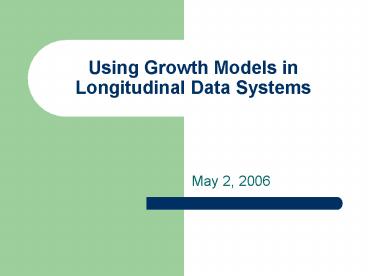Using Growth Models in Longitudinal Data Systems - PowerPoint PPT Presentation
1 / 19
Title:
Using Growth Models in Longitudinal Data Systems
Description:
Using Growth Models in Longitudinal Data Systems. May 2, 2006. Overview ... What are some of the Growth Models? ... Hierarchical Modeling Framework (CRESST model) ... – PowerPoint PPT presentation
Number of Views:109
Avg rating:3.0/5.0
Title: Using Growth Models in Longitudinal Data Systems
1
Using Growth Models in Longitudinal Data Systems
- May 2, 2006
2
Overview
- What are some of the growth models?
- What data are necessary?
- What are some of the policy implications?
3
What are some of the Growth Models?
- CCSSO book Policymakers Guide to Growth Models
for School Accountability How Do Accountability
Models Differ? - National Center for Assessments presentation at
AERA
4
What are some of the Growth Models?
- Definition of Growth Model for Accountability
- Measures progress of same students from one year
to the next - Answers the question How much, on average, did
students performance change? - May be benchmarked against a target
5
What are some of the Growth Models?
- Regression Models
- Value Tables
6
What are some of the Growth Models?
- Regression Models
- Value-Added Models
- Questions to be answered On average, did the
students change in performance meet the growth
expectation? By how much did the average change
in student performance miss or exceed the growth
expectation? - Use background characteristics or prior
achievement as controls to isolate the effects of
a school, program or teacher on student academic
progress - Tennessee Value Added Assessment System (TVAAS)
7
What are some of the Growth Models?
- Regression Models (continued)
- Hierarchical Modeling Framework (CRESST model)
- Looks at the relationship of where a student
starts and how much they grow - Complex model with complex calculations
- Hybrid Success Model (Kingsbury)
- Similar to HM model
- Looks at individual student growth at at least
two points in time using a common scale across
all grades - Based on Scale Scores
8
What are some of the Growth Models?
- REACH model (Doran)
- Uses value added results to serve as the basis
for measuring progress towards a goal - Dependent on scale scores
9
What are some of the Growth Models?
- Issues inherent in Regression Models
- Very complex with complex calculations
- Rely on scale scores and typically a vertical
scale for the assessment system - Could be difficult to explain
10
What are some of the Growth Models?
- Value Tables
- Measures individual student progress from one
year to the next using performance levels and
assigns a value to that growth - Points depend on the values or outcomes that
are desired - Calculate the average growth for a school or
subgroup
11
Sample Value Table
12
What are some of the Growth Models?
13
What data are necessary?
- Most of the systems either require
- Annual assessment systems that test at
consecutive grades - Assessments that measure at least 2 points in
time - Data systems that track students through the use
of a unique student identifier - Data systems to maintain multiple years of
assessment data - Some require vertical scales
- Some require articulated standards and
performance levels that have consistent meaning
across grades
14
What are some of the policy implications?
- Huge data systems requirement
- Infrastructure
- Data Collection
- Student Demographics
- Multiple years of assessment scores tied to
unique ID - Data Reporting
15
What are some of the policy implications?
- Measuring growth helps determine what model to
choose - What does the state value?
- How should growth be measured based on values?
16
What are some of the policy implications?
- Cost
- Multiple costs
- Data infrastructure and systems
- Assessments
- Are additional assessments necessary
- Are assessments vertically scaled or are
performance levels articulated across grades - Are content standards vertically aligned
- Resources to calculate
- Communication of growth model and results
17
What are some of the policy implications?
- NCLB Requirements
- Is model compensatory
- Not an option for NCLB use at this time
- Are all students proficient by 2014 or several
years beyond if entered close to 2013 - Is the data infrastructure there to support the
model - Are the core principles of NCLB maintained
- Are the requirements for Standards and
Assessments in place (approved through peer
review process)
18
What are some of the policy implications?
- Many more policy implications and more issues
some known and some being discovered as states
design growth models for accountability use
19
Contact Information
- Cathy Wagner
- Minnesota Department of Education
- cathy.wagner_at_state.mn.us
- Phone number
- Robin Taylor
- Delaware Department of Education
- rtaylor_at_doe.k12.de.us
- 302-735-4080































